Height 9 3/8 in (23.8 cm) Depth 3 1/4 in (8.3 cm) Material Ivory | Width 5 in (12.7 cm) Created Early 16th century | |
 | ||
Similar Bronze Head from Ife, Stadia II, Akan goldweights, The Swing | ||
The Benin Pendant Mask is an miniature sculptural portrait in ivory of the powerful Queen Mother Idia of the 16th century Benin Empire, taking the form of an African traditional mask. The likeness was worn however, not as a mask, but as a pendant by her son Esigie, who owed his kingship as Oba of Benin to the Queen Mother's military aid.
Contents
- Benin Empire
- Ritual use
- Description and interpretation
- A powerful woman
- Trade symbolism
- Provenance
- Legacy
- References
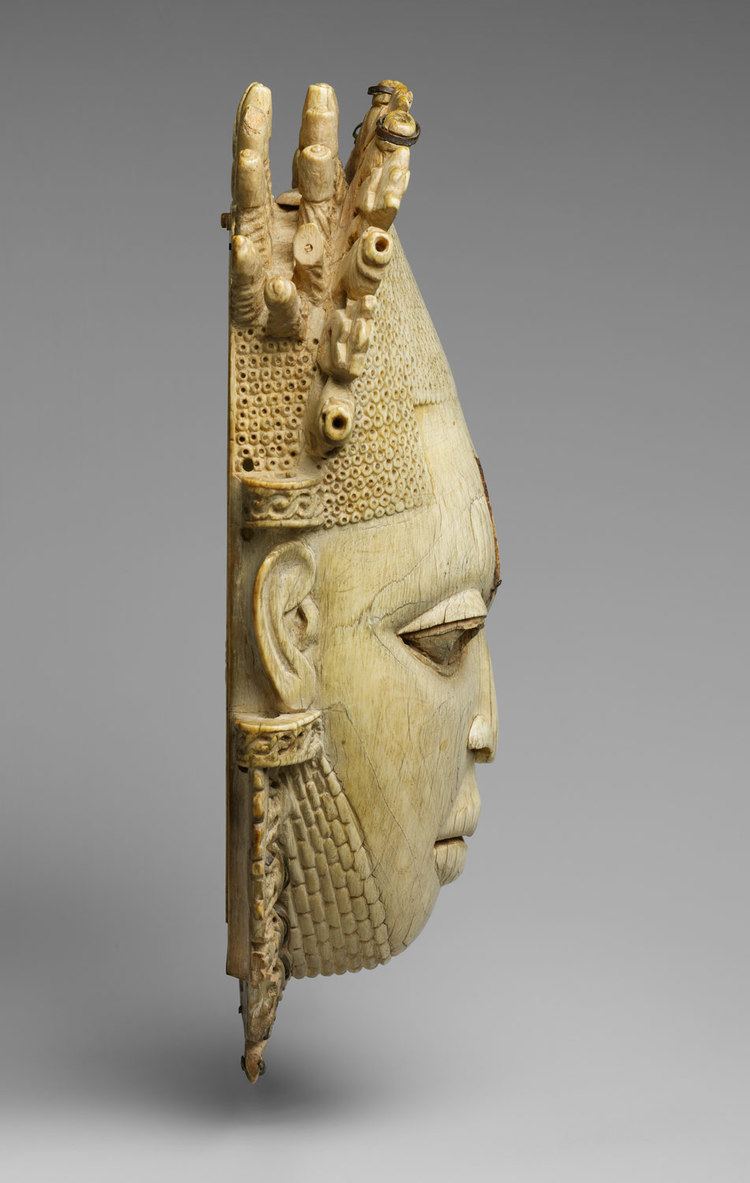
Two almost identical masks are extant: one at the British Museum in London and the other at the Metropolitan Museum of Art in New York City. Both feature a serene face of the queen mother wearing a beaded headdress, a beaded choker at her neck, scarification highlighted by iron inlay on the forehead, and all framed by the flange of an openwork tiara and collar of symbolic beings, as well as double loops at each side for attachment of the pendant.
There are also examples on the same theme at the Seattle Art Museum and the Linden Museum, and one in a private collection, all taken during the Benin Expedition of 1897.
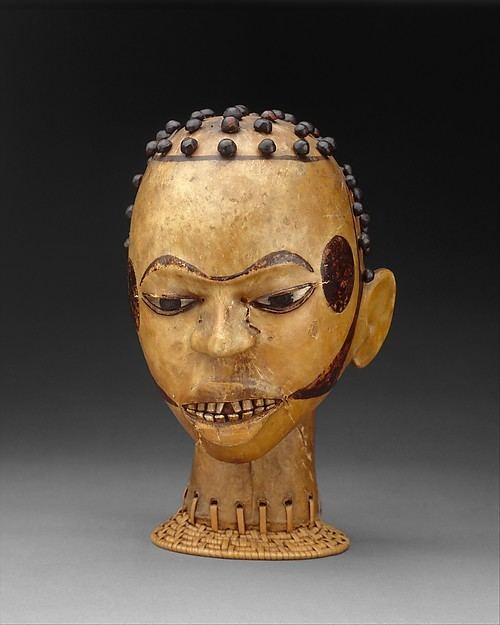
The mask has also become a cultural emblem of modern Nigeria since the Pan-Africanist FESTAC 77 cultural festival in 1977.
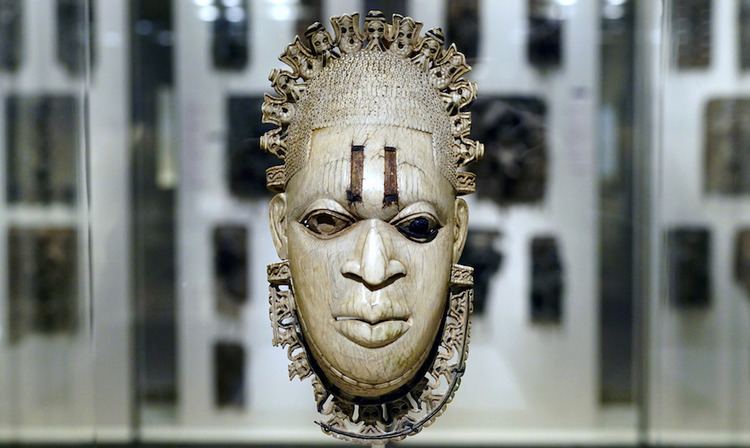
Benin Empire
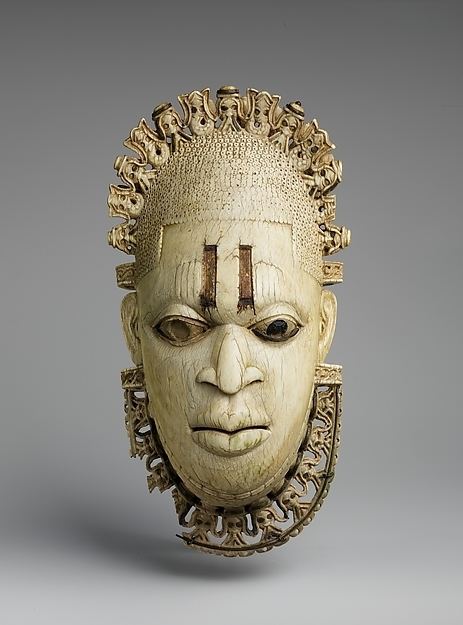
In the early 16th century, the dynamic Esigie ruled the Benin Empire of the Bini people as its oba. He came to power as Portuguese explorers first made contact with the empire. Trade and diplomacy with Europe brought Esigie and the Bini prosperity and regional influence as the empire traded pepper, ivory, local textiles, and slaves for brass, cloth, coral beads, and mercenaries for protection. Esigie engaged in two major conflicts. First, his half-brother fought a protracted civil war over the line of succession that would crown Esigie, the firstborn. Second, Esigie successfully defended against an invasion from the northern Igala Kingdom and captured their leader. Esigie rewarded his key political and mystical advisor during these trials, his mother Idia, with the title of iyoba (queen mother)—the first in a tradition of queen mother advisors. The identification with Idia was made by Oba Akenzua II in the mid-20th century.
Ritual use

The Benin oba solved problems by commissioning works from his guild of ivory and wood carvers, the Igbesanmwan. Their works were customized for their ruler, between the material connotations of ivory and the visual motifs in the carvings. At least two of the masks feature Portuguese imagery (although this imagery outlasted the actual Portuguese presence) and thus were likely created during Esigie's early-16th century rule (possibly ca. 1520), either during Idia's life or soon after her death. The similarities between the masks indicate that the masks were likely created by at the same time by the same artist. Their details match the comparable carving qualities of ivory spoons and salt cellars commissioned during the same period, the early period of Benin art, the phase of strongest affiliation with Ife or Yoruba art. Ivory works from the empire were mainly for the oba to use in ritual. The masks may have been used in ceremonies including the Ugie Iyoba commemoration of the oba's mother, as well the Emobo purification ceremony to expel bad spirits from the land. Similar pendant masks are mainly used in contemporary Emobo ceremonies focused on bad spirits, though the traditions of Emobo may have changed throughout history.
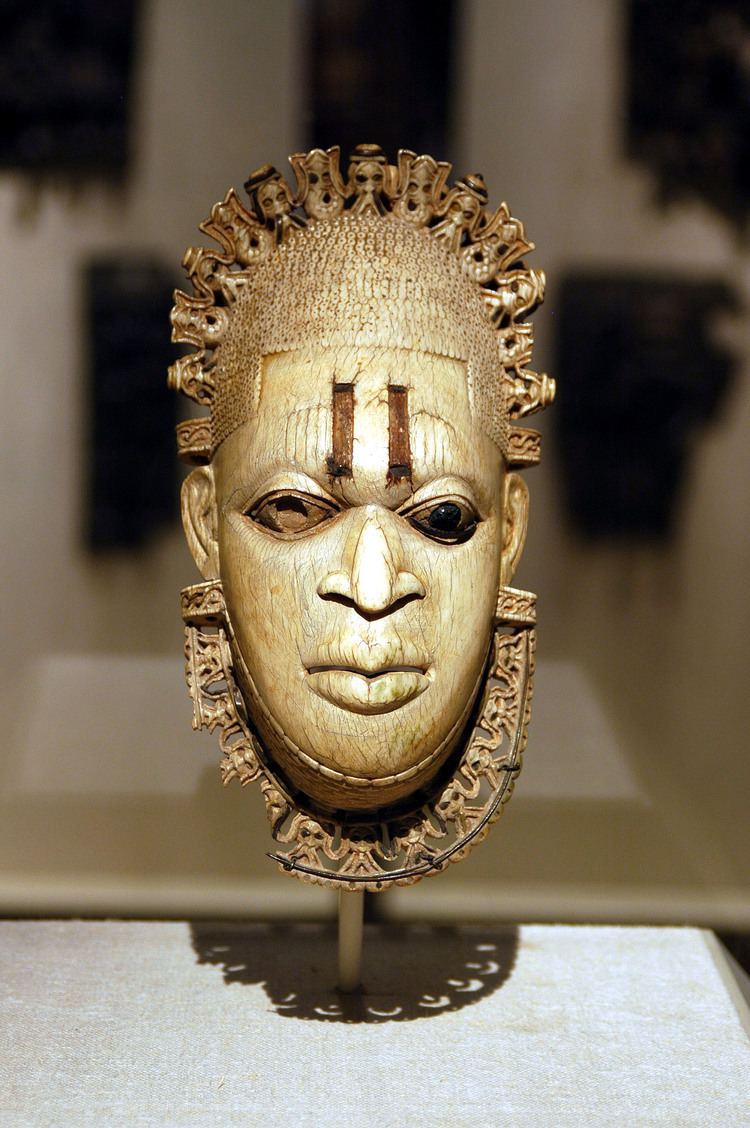
Four rungs on the side of the masks, above and below each ear, let the masks hang in suspension and indicate that the masks were suspended from a cord, though experts have disagreed on how they were worn. British Museum art historian William Fagg concluded that unlike the small brass pendant masks worn at the waist by modern kings, the ivory mask was likely worn around the neck. An 1830s drawing of a similar mask worn at the breast by a neighboring ruler confirms Fagg's theory. Based on the position of the rungs, Metropolitan curator Alisa LaGamma also affirmed the theory. Benin specialist and anthropologist Paula Ben-Amos, however, wrote that the masks were worn on the waist as pendants during the Ugie Iyoba and Emobo ceremonies. The hollow masks likely served as amuletic containers. Below the mask's collars, the ring of small loops are attachment points for crotal bells.
Description and interpretation

They are made of ivory, long and ovular in shape, and thinly carved, approaching semiopaqueness. The similar British Museum and Metropolitan masks have elaborate ornament at their hair and collar. Each mask's gaze is accentuated with iron inlay at its pupils and lower eye outline, and the eyes are slightly diverted by the eyelids. This use of inlay departed from the ways in which Europeans used ivory. Above the eyes, the four supraorbital marks are associated with Benin females. The masks' facial features are symmetrical and skillfully precise. Their lips are parted, nostrils slightly flared, and hair dense with tiny coils and a rectilinear hairline. The masks' expression of "impersonal coolness" reflected the stylistic conventions of the oba's ivory carvers guild, with a naturalism typical of craft in early Benin art.
A powerful woman
The depiction of women is rare in Benin art of this type, though the position of Idia, known to Edo tradition as "the only woman who went to war", is exceptional, and the very title of Iyoba or Queen Mother was created for her. The headdress forms part of the ukpe-okhue ("parrot's beak) hairstyle she originated, and is more clearly seen on the Bronze Head of Queen Idia. The depicted precious coral of the headdress and choker are in the form of cylindrical ikele ("royal") beads, which it was the specially-granted privilege of the Queen Mother to wear, being usually reserved for the Oba and the Edogun (war chief). The Linden Museum mask also has a string of actual ikiele beads of coral wrapped around its forehead. These red beads and red cloth, once reserved for leadership figures, have in modern times been popularly adopted as elements of Edo traditional dress.
The foreheads of both masks were are inscribed with four vertical cicatrices over each eye, with inlaid with a pair of iron strips highlighting the scarification. There is a copper alloy used beside the iron strips. Iron is also used in the pupils and rims of the eyes.
Trade symbolism
Ivory, both then and now, connotes royal wealth, power, and purity. Ivory, already a luxury commodity in Africa, became increasingly coveted with the growth of the European ivory trade. In African society, ivory indicated that its owner had the interpersonal qualities necessary to acquire wealth. When an elephant was killed in the Benin Empire, the oba received one tusk as a gift and was offered the other in sale. Thus, the oba had many tusks and controlled the ivory trade. Ivory is associated with the Bini god of the sea, Olokun. As this god gives wealth and fertility, it the spirit world's equivalent of the Benin oba. Ivory gave wealth similar to Olokun, as it enticed the Portuguese merchants who, in turn, returned wealth to Benin. The Portuguese belonged to Olokun, having arrived from the sea. The whiteness of ivory also reflects the symbolism of white chalk, whose ritual purity is associated with Olokun.
The openwork of the tiara and collar represent the tiny heads of Portuguese men in the tiara of both the Met Mask and the British Museum, with eleven figures in the British Museum mask, and in the Met mask thirteen figures of Portuguese men alternating with a mudfish, the West African lungfish. The Portuguese, who had only recently arrived in the area, were a symbol of power and affluence to the empire's royal court. Their iconography is identifiable by their long hair, hanging mustaches (often described as bearded), and domed hats. Benin ivory art historian Barbara Blackmun interprets these crown adornments as a reference to Idia's ability to conduct the Portuguese power to her son's favor. Mudfish were a common theme in Benin royal arts, and reflected the divinity of the oba. Bini cosmology believed that spirits crossed the ocean to reach the afterlife, where their leaders lived like gods. As creatures who could live on land and sea, the mudfish symbolized the duality needed for the leader's final journey, and this duality represents the seafaring Portuguese as well. The mudfish also appear in a pattern on the Linden Museum mask's crown, while the private collection mask's crown has bird elements, also formerly present on the similar Seattle Art Museum mask. The masks also differ in pattern along their bottom, collar edges. The collar of the Met mask is similarly decorated with eleven Portuguese men (with damage on its right side), while the collar of the British Museum mask is instead an abstract .guilloché latticework.
Provenance
During the 1897 punitive Benin Expedition, the British found a group of similar ivory masks in the oba's palace bedroom. The expedition's civil leader Ralph Moor took the two finest masks, which were later collected British anthropologist Charles Gabriel Seligman and transferred to the London Museum of Mankind (now the British Museum) and the New York Museum of Primitive Art (now the Metropolitan Museum of Art). Two additional masks from the bedchamber group were taken by British officers and now reside in the collections of the Seattle Art Museum (formerly Principal Medical Officer Robert Allman) and the Linden Museum in Stuttgart (formerly W. D. Webster and then Augustus Pitt Rivers), and there is one in a private collection of the heirs of Henry Galway.
Five to six masks of this type were found in a large chest in 1897 in the bedchamber of the then-reigning Oba Ovonramwen, the ruler at the Benin court. They were discovered at a time of great civil unrest during the British punitive Benin Expedition of 1897, when many artefacts were dispersed and sold to Western collectors. The British Museum's pendant was purchased in 1910 from the British anthropologist Prof Charles Gabriel Seligman.
The Met's mask was acquired in 1972 as a gift of Nelson Rockefeller. He founded the Museum of Primitive Art in 1954 after the Metropolitan Museum did not reciprocate his interest in Precolumbian art. The museum collected works for their artistic—and not anthropological—value, contrasting with the eralier history of African art in Western collections. The Queens College art historian Robert Goldwater became its director and recommended acquisitions. His argument to collect the ivory pendant mask was among his longest, at the end of 1957. He called it "the best object of its kind known, nor will any others ever turn up". Goldwater wrote that the mask was higher in quality than the similar, renowned one owned by the British Museum. The mask, he predicted, would redefine the collection and go on permanent display, on par with the Museum of Modern Art's well-known Sleeping Gypsy (1897) by Henri Rousseau. Rockefeller purchased the mask at a record price and unveiled it in September 1958. The purchase solidified a policy that Goldwater believed the museum should center around permanent collections of masterworks.
Legacy
The Benin Pendant Mask has become an iconic image of Benin art and it featured on Nigerian one Naira banknotes in 1973, and was chosen as the official emblem of the Pan-Africanist FESTAC 77 cultural festival in 1977, so that this design is often known in modern Nigeria as the FESTAC Mask. The Nigerian government was unsuccessful in securing a loan of the work from the British Museum, and commissioned Bini artist Erhabor Emokpae to recreate the mask as a 20-foot tall bronze centerpiece for the festival (on display at the National Arts Theatre since 1979), as well as developing a FESTAC flag with the mask as central charge on an unequally banded black-gold-black vertical tricolor, and being responsible for the event's extensive graphic design. Another Bini artist, Felix Idubor, was commissioned to carve two replica masks in ivory for the Nigerian National Museum. A 150kg bronze reproduction was also donated to UNESCO in 2005.
The Met's Queen Mother pendant mask is considered among the museum's most celebrated works. African art historian Ezio Bassani wrote that the profile of Met's mask was "at once delicate and strong" with a "musical rhythm", and that its use of iron and copper inlay was both "discreet and functional". He wrote that the Metropolitan and British Museum masks were among the most beautiful ivories carved in Benin, and that their artist was both refined and sensitive. Kate Ezra wrote that the mask's thinness showcased the "sensitivity and solemnity" of early Benin art.
